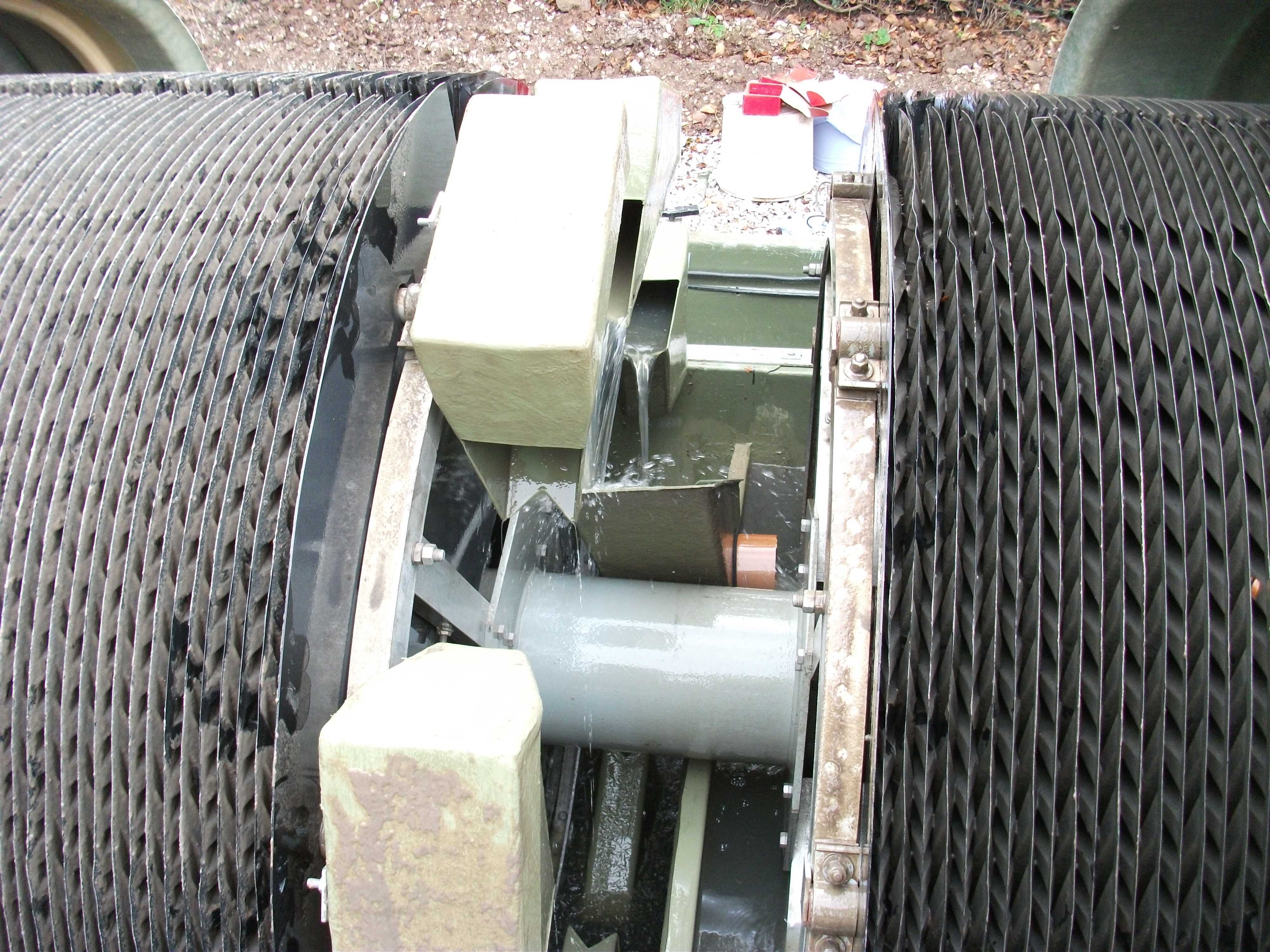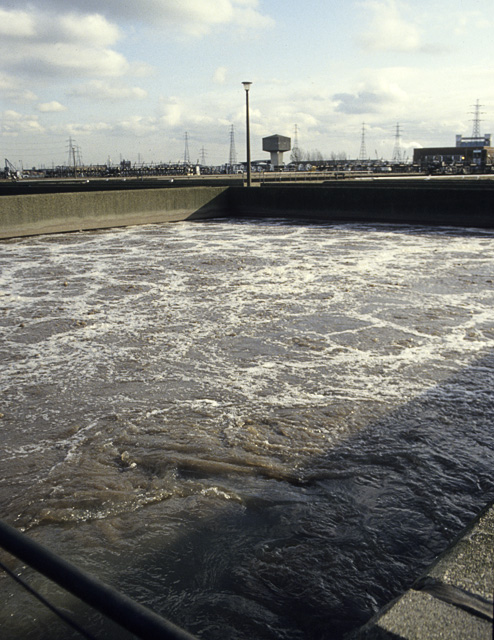|
Rotating Biological Contactor
A rotating biological contactor or RBC is a biological fixed-film treatment process used in the secondary treatment of wastewater following primary treatment. The primary treatment process involves removal of grit, sand and coarse suspended material through a screening process, followed by settling of suspended solids. The RBC process allows the wastewater to come in contact with a biological film in order to remove pollutants in the wastewater before discharge of the treated wastewater to the environment, usually a body of water (river, lake or ocean). A rotating biological contactor is a type of secondary (biological) treatment process. It consists of a series of closely spaced, parallel discs mounted on a rotating shaft which is supported just above the surface of the wastewater. Microorganisms grow on the surface of the discs where biological degradation of the wastewater pollutants takes place. Rotating biological contactors (RBCs) are capable of withstanding surges in o ... [...More Info...] [...Related Items...] OR: [Wikipedia] [Google] [Baidu] |
Aeration
Aeration (also called aerification or aeriation) is the process by which air is circulated through, mixed with or dissolved in a liquid or other substances that act as a fluid (such as soil). Aeration processes create additional surface area in the mixture, allowing greater chemical or suspension reactions. Aeration of liquids Methods Aeration of liquids (usually water) is achieved by: * passing air through the liquid by means of the Venturi tube, aeration turbines or compressed air which can be combined with diffuser(s) air stone(s), as well as fine bubble diffusers, coarse bubble diffusers or linear aeration tubing. Ceramics are suitable for this purpose, often involving dispersion of fine air or gas bubbles through the porous ceramic into a liquid. The smaller the bubbles, the more gas is exposed to the liquid increasing the gas transfer efficiency. Diffusers or spargers can also be designed into the system to cause turbulence or mixing if desired. Porous ceramic diffu ... [...More Info...] [...Related Items...] OR: [Wikipedia] [Google] [Baidu] |
Biodegradable Waste Management
Biodegradation is the breakdown of organic matter by microorganisms, such as bacteria and fungi. It is generally assumed to be a natural process, which differentiates it from composting. Composting is a human-driven process in which biodegradation occurs under a specific set of circumstances. The process of biodegradation is threefold: first an object undergoes biodeterioration, which is the mechanical weakening of its structure; then follows biofragmentation, which is the breakdown of materials by microorganisms; and finally assimilation, which is the incorporation of the old material into new cells. In practice, almost all chemical compounds and materials are subject to biodegradation, the key element being time. Things like vegetables may degrade within days, while glass and some plastics take many millennia to decompose. A standard for biodegradability used by the European Union is that greater than 90% of the original material must be converted into , water and minerals by ... [...More Info...] [...Related Items...] OR: [Wikipedia] [Google] [Baidu] |
Chemical Equipment
A chemical substance is a form of matter having constant chemical composition and characteristic properties. Some references add that chemical substance cannot be separated into its constituent elements by physical separation methods, i.e., without breaking chemical bonds. Chemical substances can be simple substances (substances consisting of a single chemical element), chemical compounds, or alloys. Chemical substances are often called 'pure' to set them apart from mixtures. A common example of a chemical substance is pure water; it has the same properties and the same ratio of hydrogen to oxygen whether it is isolated from a river or made in a laboratory. Other chemical substances commonly encountered in pure form are diamond (carbon), gold, table salt (sodium chloride) and refined sugar (sucrose). However, in practice, no substance is entirely pure, and chemical purity is specified according to the intended use of the chemical. Chemical substances exist as solids, liquids, ... [...More Info...] [...Related Items...] OR: [Wikipedia] [Google] [Baidu] |
Environmental Engineering
Environmental engineering is a professional engineering discipline that encompasses broad scientific topics like chemistry, biology, ecology, geology, hydraulics, hydrology, microbiology, and mathematics to create solutions that will protect and also improve the health of living organisms and improve the quality of the environment. Environmental engineering is a sub-discipline of civil engineering and chemical engineering. While on the part of civil engineering, the Environmental Engineering is focused mainly on Sanitary Engineering. Environmental engineering is the application of scientific and engineering principles to improve and maintain the environment to: * protect human health, *protect nature's beneficial ecosystems, *and improve environmental-related enhancement of the quality of human life. Environmental engineers devise solutions for wastewater management, water and air pollution control, recycling, waste disposal, and public health. They design municipal water ... [...More Info...] [...Related Items...] OR: [Wikipedia] [Google] [Baidu] |
List Of Waste Water Treatment Technologies
This page consists of a list of wastewater treatment technologies: See also * Agricultural wastewater treatment * Industrial wastewater treatment * List of solid waste treatment technologies *Waste treatment technologies *Water purification Water purification is the process of removing undesirable chemicals, biological contaminants, suspended solids, and gases from water. The goal is to produce water that is fit for specific purposes. Most water is purified and disinfected for hu ... * Sewage sludge treatment References * * Industrial Wastewater Treatment Technology DatabaseEPA. {{DEFAULTSORT:List Of Waste Water Treatment Technologies Chemical processes Environmental engineering *List Water pollution Water technology Waste-water treatment technologies Sanitation ... [...More Info...] [...Related Items...] OR: [Wikipedia] [Google] [Baidu] |
Industrial Wastewater Treatment
Industrial wastewater treatment describes the processes used for treating wastewater that is produced by industries as an undesirable by-product. After treatment, the treated industrial wastewater (or effluent) may be reused or released to a sanitary sewer or to a surface water in the environment. Some industrial facilities generate wastewater that can be treated in sewage treatment plants. Most industrial processes, such as petroleum refineries, chemical and petrochemical plants have their own specialized facilities to treat their wastewaters so that the pollutant concentrations in the treated wastewater comply with the regulations regarding disposal of wastewaters into sewers or into rivers, lakes or oceans. This applies to industries that generate wastewater with high concentrations of organic matter (e.g. oil and grease), toxic pollutants (e.g. heavy metals, volatile organic compounds) or nutrients such as ammonia. Some industries install a pre-treatment system to remove s ... [...More Info...] [...Related Items...] OR: [Wikipedia] [Google] [Baidu] |
Trickling Filter
A trickling filter is a type of wastewater treatment system. It consists of a fixed bed of rocks, coke, gravel, slag, polyurethane foam, sphagnum peat moss, ceramic, or plastic media over which sewage or other wastewater flows downward and causes a layer of microbial slime (biofilm) to grow, covering the bed of media. Aerobic conditions are maintained by splashing, diffusion, and either by forced-air flowing through the bed or natural convection of air if the filter medium is porous. The treatment of sewage or other wastewater with trickling filters is among the oldest and most well characterized treatment technologies. The fundamental components of a complete trickling filter system are: * a bed of filter medium upon which a layer of microbial slime is promoted and developed; * an enclosure or a container which houses the bed of filter medium; * a system for distributing the flow of wastewater over the filter medium; and * a system for removing and disposing of any sludge fr ... [...More Info...] [...Related Items...] OR: [Wikipedia] [Google] [Baidu] |
Aerated Lagoon
An aerated lagoon (or aerated pond) is a simple wastewater treatment system consisting of a pond with artificial aeration to promote the biological oxidation of wastewaters. There are many other aerobic biological processes for treatment of wastewaters, for example activated sludge, trickling filters, rotating biological contactors and biofilters. They all have in common the use of oxygen (or air) and microbial action to reduce the pollutants in wastewaters. Types *Suspension mixed lagoons, where there is less energy provided by the aeration equipment to keep the sludge in suspension. * Facultative lagoons, where there is insufficient energy provided by the aeration equipment to keep the sludge in suspension and solids settle to the lagoon floor. The biodegradable solids in the settled sludge then degrade as in an anaerobic lagoon. Suspension mixed lagoons Suspension mixed lagoons flow through activated sludge systems where the effluent has the same composition as th ... [...More Info...] [...Related Items...] OR: [Wikipedia] [Google] [Baidu] |
Activated Sludge
The activated sludge process is a type of biological wastewater treatment process for treating sewage or industrial wastewaters using aeration and a biological floc composed of bacteria and protozoa. It uses air (or oxygen) and microorganisms to biologically oxidize organic pollutants, producing a waste sludge (or floc) containing the oxidized material. The activated sludge process for removing carbonaceous pollution begins with an aeration tank where air (or oxygen) is injected into the waste water. This is followed by a settling tank to allow the biological flocs (the sludge blanket) to settle, thus separating the biological sludge from the clear treated water. Part of the waste sludge is recycled to the aeration tank and the remaining waste sludge is removed for further treatment and ultimate disposal. Plant types include package plants, oxidation ditch, deep shaft/vertical treatment, surface-aerated basins, sequencing batch reactors (SBRs). Aeration methods include diffu ... [...More Info...] [...Related Items...] OR: [Wikipedia] [Google] [Baidu] |
Severn Trent
Severn Trent plc is a water company based in Coventry, England. It supplies 4.6 million households and business across the Midlands and Wales. It is traded on the London Stock Exchange and a constituent of the FTSE 100 Index. Severn Trent, the trading name owned by the company, applies to a group of companies operating across the United Kingdom, United States and mainland Europe, with some involvement in the Middle East. It took its name from the two predecessor River Authorities, which managed the catchment of the Severn and the Trent. History The Severn Trent Water Authority was established in 1974. In July 1989, the Severn Trent Water Authority was partially privatised under the Water Act 1989, together with the rest of the water supply and sewage disposal industry in England and Wales, to form Severn Trent Water, with a responsibility to supply freshwater and treat sewage for around 8 million people living in the Midlands of England and also a small area of Wales. ... [...More Info...] [...Related Items...] OR: [Wikipedia] [Google] [Baidu] |








